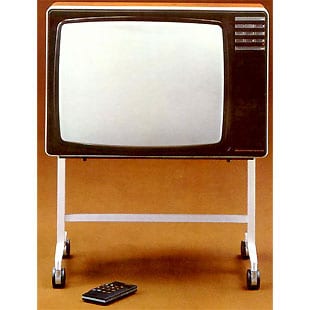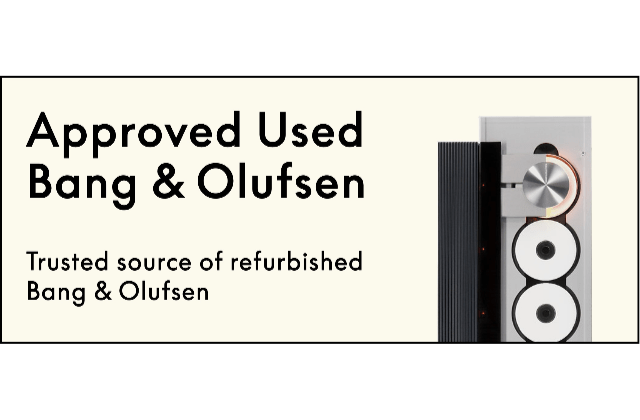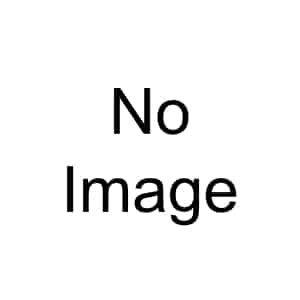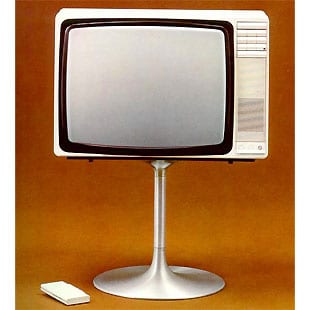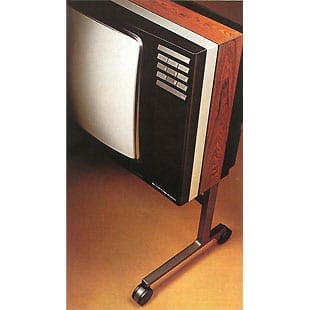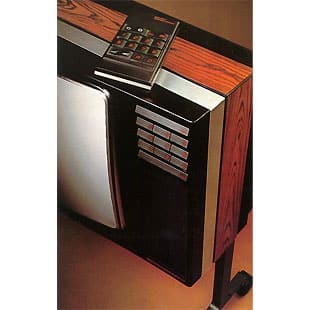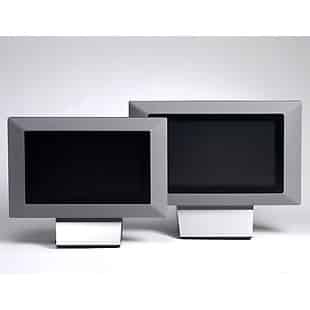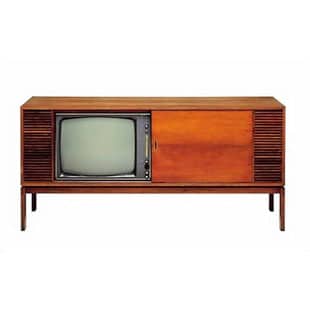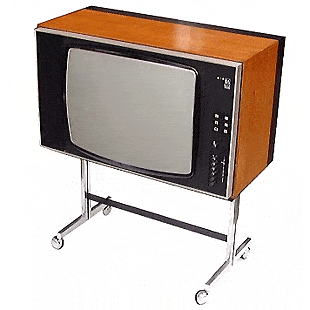BeoVision 3-28
Standard features:
– Set Top Box controller
– Power Link connection
– Remote: BEO4. (Supplied with the set)
– 8 Menu languages (UK, D, F, I, NL, E, S, DK)
– PIN code protection for all markets
Optional features :
– SAT-receiver (DVB-S)
– ML-module (Master/Slave)
– System modulator
– Digital Surround Sound (AC-3/DTS)
– Coated front glass
– Motorised Base Type 4179
– Dolby Digital/DTS Type 4005
– MasterLink Module Type 4015
– RF Modulator Type 4018
CTV
Dimensions
W x H x D/Weight 85,0 x 70,0 x 52,0cm/ 45 kg
Cabinet finish
Black, Blue, Yellow, Grey, Red, Green.
Power consumption
Typical 115 W, standby 0.5 W
Terminal included
Beo4
Picture tube (Visual picture)
70cm, 16:9, RF, 50Hz, Black line, Black Matrix (66cm)
Contrast screen
(Grey glass)
VisionClear
Automatic picture control
Auto cut-off
CTI
Adaptive Luminance Peaking
Adaptive black
Scan Velocity Modulation
Teletext
Improved Teletext, Level 2.5
9 memory pages per programme
CTV system
According to type: B/G/D/K/I/L/L´/M, PAL/SECAM, NTSC on AV
Tuner
Full range, 45 – 860 MHz
Pre-tuned TV programmes
99, auto naming
8 Programme Groups
Stereo decoders
A2 + NICAM
Menus: Languages
English, Danish, Dutch, Spanish, Italian, German, French, Swedish
Speakers
Power amplifier modules
2 units, full range
Frequency range
85-20,000 Hz
Max sound pressure level
94 dB
Cabinet principle/Net volume
Bass Reflex/2.1 litres
Woofer
90 mm
Bass equaliser
Adaptive
Magnetic shielded
Yes
Input TV
Aerial, 1 x 75 ohms
V.Tape – AV/Decoder
2 x 21-pin for V.TAPE, A/V or Decoder. RGB and S-Video in.
Camcorder/Auxiliary
3 x phono sockets (video in/audio L-R in)
Headphone socket
Mini jack
Power Link
2 x 8-pin sockets
Master Link (Optional)
1 x Master Link
System modulator (Optional)
1 x 75 ohm aerial male (Splitter/System modulator Output).
Set-top box Controller
Digital Surround Sound module
(AC-3/DTS)
Motorised stand operation
Mini jack
5 x 8-pin sockets
1 X 5 pin socket
Contrast screen, Anti-reflex coated *)
Master Link Module
4015
System Modulator EU
System Modulator GB
Digital Surround Sound module
4016
4018
4005
(AC-3/DTS)
*) BeoVision 3 – 28 with built-in AR coated glass only available ex. factory
Stands
Type:
Height inc. TV
Video stand
Motorised base (For video stand)
Motorised base (For TV)
4068
4066
4179
112 cm 1115 mm
112 cm 1119 mm
72 cm
Market Specifications:
Market:
Type:
Country:
Active CTV system
Basic CTV system *)
System modulator
8850
8852
8853
8855
8856
8858
BeoVision 3-32
BeoVision 3 – 32
Dimensions W x H x D: 96 x 77 x 58cm Weight: 65 kg
Front Cloth Colours: Red, Black, Grey, Dark Grey, Green, Blue, Yellow
Power consumption: Typical 134 watt/stand-by < 1.8 watt
Terminal included: Beo4
Picture tube/Visual picture 81 cm / 76 cm (16:9)
Wide-Screen, Real Flat
Curtain: Electronic
Contrast screen (Optional): Anti-reflex coating
VisionClear:
Auto picture adjustment
Auto cut-off
Digital CTI
Adaptive Luminance Peaking
Scan Velocity Modulation
Improved letterbox
Motion Clear
Teletext:
Teletext level 2*, 1780 pages
Wide Screen Signalling (WSS)
FastText (FLOF), 4 memory pages per program
17 Teletext languages in 7 groups
Group 0 English, German, Swedish, Italian, French, Spanish/Portuguese, Czech/Slovak
Group 1 Polish, German, Swedish, Italian, French, Serbo-croat, Czech/Slovak, Romanian
Group 2 English, German, Swedish, Italian, French, Spanish/Portuguese, Turkish
(Russian) Group 3 English, Russian, Estonian, Czech/Slovak, German, Lithuanian/Lettish, Ukrainian
(Greece) Group 4 English, German, Swedish, Italian, French, Spanish/Portuguese, Turkish, Greek
(Arabic) Group 5 English, Arabic, French
(Hebrew) Group 6 English, Hebrew, Arabic
Tuning: Auto-tune, program move and semiautomatic naming
Tuner range: 45 – 860 MHz, VHF, S, Hyper, UHF
TV programmes: 99
Stereo decoders: A2 + NICAM
Theft protection: With pin-code or Disabled
Speakers :
Power amplifier modules:
4 units
Long term max. output power per module: 39 watts
Frequency range: 55 – 20,000 Hz
Max. sound pressure level: 96 dB
Cabinet principle/ Net volume: Bass Reflex / 3.5 litres
Woofer: 115 mm
Tweeter: 18 mm
Bass equalizer: Adaptive
Magnetic shielded: Yes
Dolby® Digital Decoder : (optional)
Decoding capabilities:
Dolby® Digital 5.1 channel decoding
Dolby® Pro-Logic decoding of two channel Dolby® Digital
Dolby® Pro-Logic decoding of two channel PCM
Dolby® Pro-Logic decoding of two analogue channels (Lt/Rt)
Automatic format detection (Dolby® Digital, PCM)
Calibration :
3 channel Tone control & loudness (L/C/R)
Bass management, Delay management
Sound modes (Speaker 1 – 5):
Speaker 1:
Stereo internal speakers (Subwoofer muted)
Speaker 2 2.0/2.1 :
Stereo external speakers / Stereo external speakers + Subwoofer
Speaker 3 3.0/3.1 :
Dolby®-3 stereo / Dolby®-3 stereo + Subwoofer
Speaker 4 4.0/4.1 :
Stereo-4 / Stereo-4 + Subwoofer
Speaker 5 5.0/5.1 :
Dolby® Digital or Dolby® Pro-Logic Surround / Dolby® Digital + Subwoofer
Connections :
– Digital audio input
– External BeoLab speakers:
2 x Coax phono, Input-1 for AV-SCART, Input-2 for DECODER-SCART
5 x Power Link (Left, Right, Rear left, Rear right, Subwoofer. – Internal Centre)
Speakers recommended, Front/Rear:
BeoLab 8000, BeoLab 6000, BeoLab 4000 or BeoLab1
Speakers recommended, Subwoofer: BeoLab 2
System modulator : (optional):
Splitter/System modulator output to Link Room (Beolink Video Distribution)
Frequency range:
479 – 831 MHz (in 1 MHz step), Dual side band
Video:
Automatic Gain Control
Audio:
Mono
According to type : FM sound system G : 5.5MHz, FM sound system I : 6MHz
Connection: 1 x 75 ohm arial male
Satellite module : (optional)
Tuner range: 950 – 2150 Mhz
Programmes: 119 TV/Radio
Sound systems: Mono/Stereo
Satellite radio: Yes
Down conv. Supply:
14/18 Volts control, Tone control (22 Khz)
DiSEqC (One way control)
Connections: 2 x F-connector (2 x 75 ohm)
Set Top Box-Controller : (optional)
Controlling boxes with BEO4:
Supported boxes : Se list at Bang & Olufsen Retail System (via internet)
Controlling one or two boxes (2 x STB):
1 box controlled by use of the IR-blaster included in the kit.
2 box controlled by use of the IR-blaster included in the kit and IR Y-adaptor(6174171) and one more IR-blaster(8330352).
Connection: 1 x Stereo mini jack
